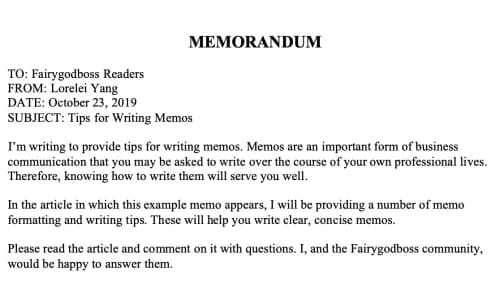Yes, You Still Need to Know How to Write a Memo in 2019
Memos are important documents for Internal business communication. But many people don't have much, if any, memo-writing experience before they join the workforce. If you're ever asked to write a memo, you may be at a loss. Luckily, though, there are a few easy tips and rules of thumb to follow to craft effective memos.
How do you write a memo?
When writing a memo, its purpose — articulating key points — is the most important thing to keep in mind. As a memo is a purely functional form of communication, its format is driven by the overall goal of clear, efficient communication. The steps for writing a memo are as follows:
- Type MEMORANDUM at the top of the page in large, bold font.
- On the next line, address the memo appropriately using the format "TO: [Audience]." For example, a memo to all employees at a company would be "TO: All Employees."
- Add any additional recipients not in the main audience in a CC line using the format "CC: [Person]." For example, a CC may be needed to keep someone informed about the issues you're addressing in the memo.
- Write your own name in the FROM line in the format "FROM: [Your Name]." You may also include your job title here.
- Include the date written out in full [Month DD, YYYY format]. Write it out in the format "DATE: [Month DD, YYYY]."
- Add the subject of the memo in the format "SUBJECT: [Topic]."
- In the memo body, clearly and concisely communicate the information the memo concerns as efficiently as possible
- End on a call to action, if appropriate. Many memos will call for readers to act on a particular issue. If that's the case for your memo, it should close on that note.
- Close the memo with a 1-3 sentence summary that ends on a positive note.
- Sign the memo.
How do you format a memo?
A properly formatted memo has a few important components:
Memo letterhead or business letterhead.
Some organizations might have special letterhead designed for memos — if that's the case at your organization, you should write your memo on it. If you don't have memo letterhead but do have business letterhead, you should use that.
Easily readable formatting.
Memos should be written in a standard (Times New Roman or Arial), size-12 font. Margins on all sides should be one inch.
Paragraphs should be written in "block" style, which means leaving a line between paragraphs and not indenting the first line.
Proofread.
Before finalizing a memo, the writer should be sure to review and edit it to ensure that it's error-free, with proper spelling, grammar and punctuation. Memos should also be edited with an eye to clarity, concision and consistency in language. Wherever possible, overly-academic terms or technical jargon should be avoided.
Signed or initialed by the author.
A memo's author should either be signed at the end by the author or have her initials by their name in the header block.
How long should a memo be?
When writing a memo, less is more. You want to get your point across as in a concise way so the memo's recipients read them as quickly as possible. Sentences should average fewer than 20 words, and paragraphs should average fewer than seven lines. The full memo should be one page at most.
Sample memo formats.
The following formats may be used for three common memo types: memos without CCs, memos with CCs, and memos with attachments.
Memo without CC
MEMORANDUM
To: [Audience]
From: [First Name] [Last Name], [Job Title]
Date: {Month} [DD], [YYYY]
Subject: [Brief subject line]
[Memo body]
Memo with CC
MEMORANDUM
To: [Audience]
CC: [First Name] [Last name]
From: [First Name] [Last Name], [Job Title]
Date: {Month} [DD], [YYYY]
Subject: [Brief subject line]
[Memo body]
Memo with attachment
MEMORANDUM
To: [Audience]
From: [First Name] [Last Name], [Job Title]
Date: {Month} [DD], [YYYY]
Subject: [Brief subject line]
[Memo body]
Attachments: [Description(s) of attachment(s) with semicolons between attachments, if multiple]
Example

Don’t miss out on articles like these. Sign up!
--
Lorelei Yang is a New York-based consultant and freelance writer/researcher. Find her on Twitter and LinkedIn.
Why women love us:
- Daily articles on career topics
- Jobs at companies dedicated to hiring more women
- Advice and support from an authentic community
- Events that help you level up in your career
- Free membership, always
